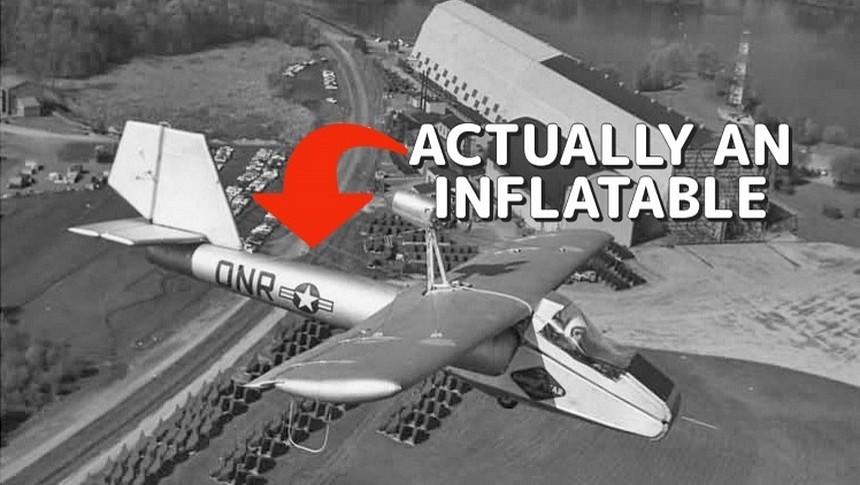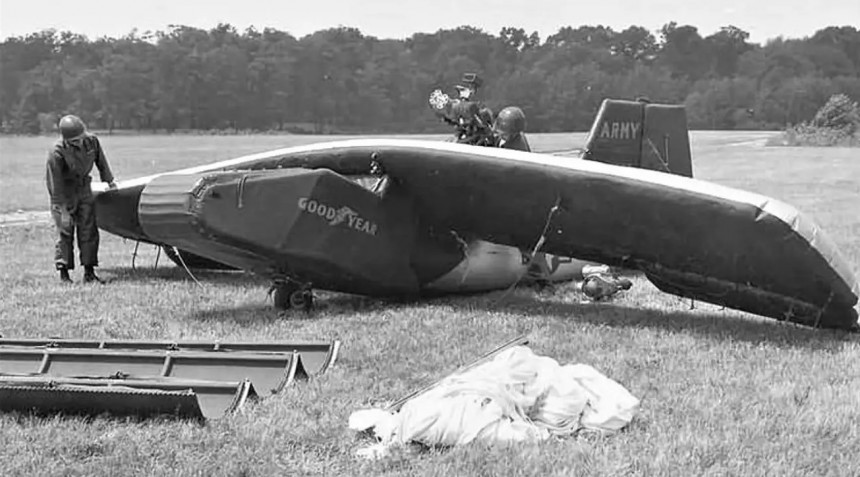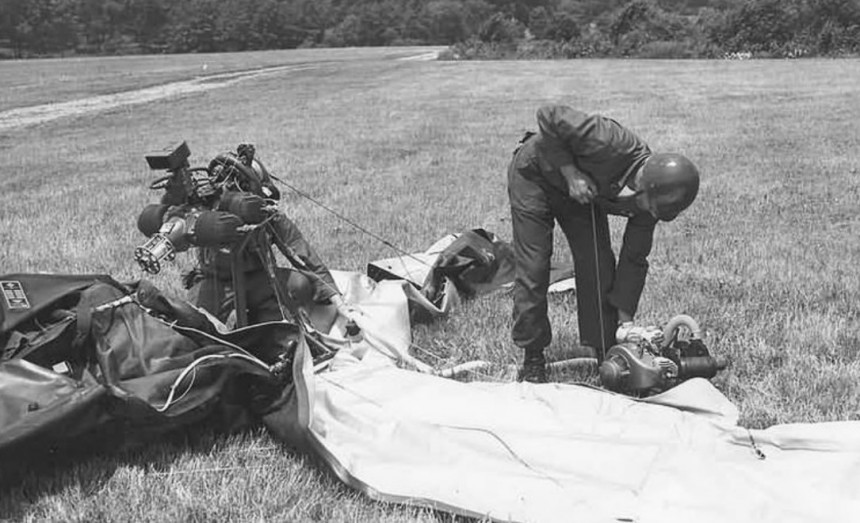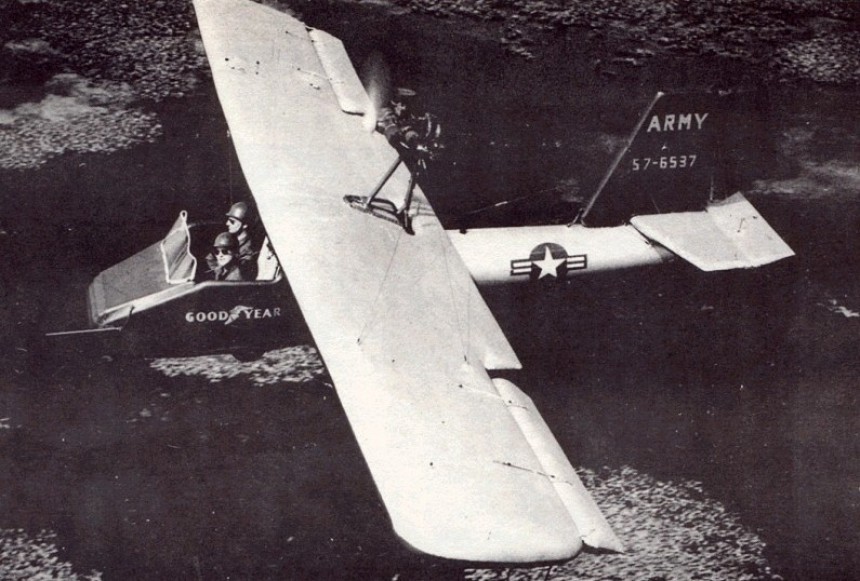Flight, humanity's long-standing dream. The instant, readily-available, easy, and individual ability to take flight, preferably available for civilian, recreational use, also fueled the dream behind Goodyear's Inflatoplane, an airplane you could inflate and take off with in less than 10 minutes.
Today, the same desire to offer civilians, even untrained ones, the ability to take off at a few minutes' notice and with minimal training or preparation is feeding the "flying car" frenzy. VTOLS, vertical takeoff and landing aircraft, whether electric or not, are hailed as the future of personal urban mobility and viable car replacements, but it's ok if you're not exactly holding your breath for them. Even optimists will tell you that they're far away into the future and will have to overcome huge hurdles to get there.
What today's dream of flying cars has in common with the Inflatoplane is the desire to make man fly. The difference between the two is that the Inflatoplane started that way but soon changed course, as Goodyear realized it could have applications in the military, whether for surveillance and aerial recognizance or rescue operations. More specifically, the U.S. military considered the Inflatoplane a viable solution for self-rescue operations in cases of downed pilots behind enemy lines.
The idea of an inflatable plane might seem ridiculous today, but it was one that held strong appeal for inventors back in the day. The first patented inflatable aircraft was the creation of Taylor McDaniel, which was a glider that bounced off upon impact in case of a crash, allowing the pilot to emerge more or less unscathed from an otherwise fatal crash. Russia and the UK picked up on the idea and did their own versions of the aircraft, though nothing concrete came out of their tests and prototypes.
That's because these inflatable aircraft, though sound in theory and with some proven functionality in real-life scenarios, lacked structural rigidity and were too slow. They were airplane-shaped balloons and acted that way when you least wanted them to, i.e., in case of an unforeseen event that resulted in a crash. A thicker and more rigid material was needed, and as luck would have it, Goodyear had just invented it.
That material was Airmat, a new type of composite with a rubber layer sandwiched between two layers of fabric, with a neoprene layer on top. Use that to make a plane, and you got an aircraft that had more structural rigidity and was more aerodynamic. So this is exactly what Goodyear did, starting in 1956.
The media called it Flying Dumbo, The Flying Mattress, The Pocket Airplane, The Flying Inner Tube, and Bag O' Wind, but Goodyear called it the Inflatoplane. It was a one-person aircraft with the tail, fuselage, and cockpit made of two walls of Airmat connected by nylon threads and only a handful of metal parts.
Initially powered by a two-cycle, 40 hp engine, later upgraded to a 42 hp one, the Inflatoplane could be inflated halfway with a hand pump, and then you'd turn on the engine that would do the rest of the work. Compact, it could fit into the back of a car, so Goodyear imagined a future when regular Joes could beat workweek traffic by simply taking it out, inflating it, and flying where they needed to be. From the moment you took it out to the moment of takeoff, it was a 10-minute, one-man job.
The Inflatoplane needed a stretch of 350 feet (106.5 meters) to land and 250 feet (76.2 meters) for takeoff. Weighing 205 lbs (93 kg) empty, it carried a fuel tank of 20 gallons (75.7 liters) and had a maximum payload of 329 lbs (149.2 kg). Range was 390 miles (627 km) or 6.5 hours, and it would cruise at 60 mph (96.5 kph) and 10,000 feet (3,048 meters). It wasn't very fast, but it was precisely what Goodyear wanted: a one-person aircraft you could inflate and fly right away with.
Between 1956 and 1959, Goodyear built 12 such Inflatoplanes, one of which was a two-person version with a more powerful 60-hp McCulloch engine. Ten of these were sent over to the U.S. military for testing for a possible application in rescuing downed pilots. The U.S. Army believed they could drop the Inflatoplane package out of passing jets, so the pilot caught behind enemy lines would have something to help him in his attempt to get back to safety.
It would be a few years later before they realized that if that pilot's jet had been shot down, the Inflatoplane would be a much easier target, being considerably slower. In all fairness, the Inflatoplane wasn't easy to shoot down since the engine would keep pressure constant within the frame. It would continue flying even after taking mild fire.
Still, the Inflatoplane never caught on. As the military continued conducting tests, two accidents occurred, in which the wing got caught in the propeller, and one resulted in the pilot's death. Whatever big plans the Army had for the Inflatoplane came to a stop then, and Goodyear lost hope: if you can't get the military sold on such an idea, what's the chance Joe at home would be interested in the "vacation kit"?
Still, Goodyear continued testing until 1972 but officially shut down the program in 1973. Of the 12 Inflatoplanes built, only three have survived. They can now be seen at the Smithsonian Institution, the Franklin Institute in Philadelphia, and the Ohio Historical Society in Columbus.
The air went out of this Bag O' Wind.
What today's dream of flying cars has in common with the Inflatoplane is the desire to make man fly. The difference between the two is that the Inflatoplane started that way but soon changed course, as Goodyear realized it could have applications in the military, whether for surveillance and aerial recognizance or rescue operations. More specifically, the U.S. military considered the Inflatoplane a viable solution for self-rescue operations in cases of downed pilots behind enemy lines.
The idea of an inflatable plane might seem ridiculous today, but it was one that held strong appeal for inventors back in the day. The first patented inflatable aircraft was the creation of Taylor McDaniel, which was a glider that bounced off upon impact in case of a crash, allowing the pilot to emerge more or less unscathed from an otherwise fatal crash. Russia and the UK picked up on the idea and did their own versions of the aircraft, though nothing concrete came out of their tests and prototypes.
That material was Airmat, a new type of composite with a rubber layer sandwiched between two layers of fabric, with a neoprene layer on top. Use that to make a plane, and you got an aircraft that had more structural rigidity and was more aerodynamic. So this is exactly what Goodyear did, starting in 1956.
The media called it Flying Dumbo, The Flying Mattress, The Pocket Airplane, The Flying Inner Tube, and Bag O' Wind, but Goodyear called it the Inflatoplane. It was a one-person aircraft with the tail, fuselage, and cockpit made of two walls of Airmat connected by nylon threads and only a handful of metal parts.
Initially powered by a two-cycle, 40 hp engine, later upgraded to a 42 hp one, the Inflatoplane could be inflated halfway with a hand pump, and then you'd turn on the engine that would do the rest of the work. Compact, it could fit into the back of a car, so Goodyear imagined a future when regular Joes could beat workweek traffic by simply taking it out, inflating it, and flying where they needed to be. From the moment you took it out to the moment of takeoff, it was a 10-minute, one-man job.
Between 1956 and 1959, Goodyear built 12 such Inflatoplanes, one of which was a two-person version with a more powerful 60-hp McCulloch engine. Ten of these were sent over to the U.S. military for testing for a possible application in rescuing downed pilots. The U.S. Army believed they could drop the Inflatoplane package out of passing jets, so the pilot caught behind enemy lines would have something to help him in his attempt to get back to safety.
It would be a few years later before they realized that if that pilot's jet had been shot down, the Inflatoplane would be a much easier target, being considerably slower. In all fairness, the Inflatoplane wasn't easy to shoot down since the engine would keep pressure constant within the frame. It would continue flying even after taking mild fire.
Still, Goodyear continued testing until 1972 but officially shut down the program in 1973. Of the 12 Inflatoplanes built, only three have survived. They can now be seen at the Smithsonian Institution, the Franklin Institute in Philadelphia, and the Ohio Historical Society in Columbus.
The air went out of this Bag O' Wind.













